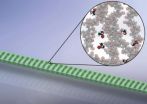(Press-News.org) Do you still believe that fish are dumb and cannot feel pain? That we do not have to worry much about how they are cared for or caught? Think again, says Culum Brown of Macquarie University in Australia, in a review article in Springer's journal Animal Cognition. The research notes that fish cognition and their sensory perception are generally on par with that of other animals. Brown therefore argues that more consideration should be given to fish welfare and anti-cruelty issues.
The Australian researcher says that most people rarely think about fish other than as food, or as pets. However, they are second only to mice in terms of the numbers used in scientific research, and the more than 32,000 known species of fish far outweigh the diversity of all other vertebrates combined. Very little public concern – which is so important to inform policy – is ever noted about fish welfare issues. Brown believes this relates to incorrect perceptions about the intelligence of fish, and ultimately of whether they are conscious. Such attitudes are also influenced because humans rarely come into contact with fish in their natural environments.
Brown's review focuses especially on bony fish. It suggests that fish are, in fact, far more intelligent than many previously believed. Fish have very good memories, live in complex social communities where they keep track of individuals, and can learn from one another. This helps to develop stable cultural traditions. Fish even recognize themselves and others. They also cooperate with one another and show signs of Machiavellian intelligence, such as cooperation and reconciliation. They build complex structures, are capable of using tools, and use the same methods for keeping track of quantities as humans do. For the most part the primary senses of fish are just as good, and in many cases, better, than that of humans. Their behavior is very much the same as that of primates, except that fish do not have the ability to imitate.
The level of mental complexity fish display is on a par with most other vertebrates, while there is mounting evidence that they can feel pain in a manner similar to humans. While the brains of fish differ from other vertebrates, fish have many analogous structures that perform similar functions. Brown concludes that if any animals are sentient, fish must be considered to be so too.
"Although scientists cannot provide a definitive answer on the level of consciousness for any non-human vertebrate, the extensive evidence of fish behavioral and cognitive sophistication and pain perception suggests that best practice would be to lend fish the same level of protection as any other vertebrate," concludes Brown, who acknowledges that such a move has implications for the fishing industry, among others. "We should therefore include fish in our 'moral circle' and afford them the protection they deserve."
INFORMATION:
Reference:
Brown, C. (2014). Fish intelligence, sentience and ethics. Animal Cognition. DOI 10.1007/s10071-014-0761-0.
Not so fast -- our fishy friends can also feel pain
Review of mental ability shows fish are on par with most animals
2014-06-17
ELSE PRESS RELEASES FROM THIS DATE:
$2.4 million NIH center grant to develop a cleaner, healthier environment in Detroit
2014-06-17
DETROIT — With over $2.4 million in new federal funding, Wayne State University researchers, regional collaborators at Henry Ford Health System, the University of Michigan and Michigan State University, and community partners will study how exposures to stressors that are prevalent in the urban industrialized environment — both chemical and non-chemical — impact human health in Detroit and beyond.
The grant, Center for Urban Responses to Environmental Stressors (CURES), is one of approximately 20 select P30 Core Centers funded by the National Institute of Environmental ...
Do 'walkable' neighborhoods reduce obesity, diabetes?
2014-06-17
June 17, 2014 (San Francisco) – People who live in neighborhoods that are conducive to walking experienced a substantially lower rate of obesity, overweight and diabetes than those who lived in more auto-dependent neighborhoods, according to a pair of studies presented at the American Diabetes Association's 74th Scientific Sessions®.
Researchers in Canada compared adults living in the most and least "walkable" metropolitan areas in southern Ontario and found a lower risk of developing diabetes over a 10-year period for those who lived in neighborhoods with less sprawl, ...
Heparin derivative suppresses neuroblastoma tumor growth
2014-06-17
DURHAM, N.C. -- Researchers at Duke Medicine have identified a new strategy for treating neuroblastoma using a modified version of heparin, a century-old injectable drug that thins the blood to prevent clots from forming.
The study, conducted in mice and published June 17, 2014, in the Journal of Clinical Investigation, found that when heparin is altered to remove its blood-thinning properties, it can suppress and shrink neuroblastoma tumors without causing severe bleeding.
"Our research translates mechanistic insights about heparin into a potential new therapy for ...
Urban Water Management Workshop stresses more collaboration and innovation
2014-06-17
RIVERSIDE, Calif. — Where sustainability of water management is concerned, we must pay more attention to long-term solutions. Efficient water management and policy ought to be promoted at the local level. And a "portfolio approach" to water management is encouraged, one that includes information campaigns, different types of pricing, supply and reuse options, and technology-based rebate programs.
These are some of the key messages that emerged from the first Urban Water Management Workshop that took place earlier this month at the University of California, Riverside.
Sponsored ...
Swell new sensors
2014-06-17
WASHINGTON D.C., June 17, 2014 – Using microscopic polymer light resonators that expand in the presence of specific gases, researchers at MIT's Quantum Photonics Laboratory have developed new optical sensors with predicted detection levels in the parts-per-billion range. Optical sensors are ideal for detecting trace gas concentrations due to their high signal-to-noise ratio, compact, lightweight nature, and immunity to electromagnetic interference.
Although other optical gas sensors had been developed before, the MIT team conceived an extremely sensitive, compact way ...
Ultra-thin wires for quantum computing
2014-06-17
WASHINGTON D.C., June 17, 2014 - Take a fine strand of silica fiber, attach it at each end to a slow-turning motor, gently torture it over an unflickering flame until it just about reaches its melting point and then pull it apart. The middle will thin out like a piece of taffy until it is less than half a micron across -- about 200 times thinner than a human hair.
That, according to researchers at the Joint Quantum Institute at the University of Maryland, is how you fabricate ultrahigh transmission optical nanofibers, a potential component for future quantum information ...
Study reveals conditions linked to deadly bird flu and maps areas at risks
2014-06-17
BEIJING, CHINA (17 June 2014)—A dangerous strain of avian influenza, H7N9, that's causing severe illness and deaths in China may be inhabiting a small fraction of its potential range and appears at risk of spreading to other suitable areas of India, Bangladesh, Vietnam, Indonesia and the Philippines, according to a new study published today in the journal Nature Communications.
Researchers from the Université Libre de Bruxelles (ULB), the International Livestock Research Institute (ILRI), Oxford University, and the Chinese Center of Disease Control and Prevention analyzed ...
Potential cholesterol lowering drug has breast cancer fighting capabilities
2014-06-17
COLUMBIA, Mo. – Researchers at the University of Missouri have proven that a compound initially developed as a cholesterol-fighting molecule not only halts the progression of breast cancer, but also can kill the cancerous cells.
"Cholesterol is a molecule found in all animal cells and serves as a structural component of cell membranes," said Salman Hyder, the Zalk Endowed Professor in Tumor Angiogenesis and professor of biomedical sciences in the College of Veterinary Medicine and the Dalton Cardiovascular Research Center at MU. "Because tumor cells grow rapidly they ...
Bats make social alliances that affect roosting behavior
2014-06-17
Depending on habitat availability, the endangered Indiana bat may be able to use its social connections to survive a certain amount of roost destruction, according to research by scientists at Virginia Tech and The Ohio State University.
Alexander Silvis of Lynchburg, Ohio, and Andrew Kniowski of Boones Mill, Virginia, both doctoral students in Virginia Tech's College of Natural Resources and Environment, made findings from Ohio State field studies highly visual by applying graphic and spatial approaches to the data.
"Social dynamics are important to bat roosting behavior," ...
Researchers map genomic differences in yellow fever, malaria mosquitoes
2014-06-17
Virginia Tech entomologists have developed a chromosome map for about half of the genome of the mosquito Aedes agypti, the major carrier of dengue fever and yellow fever.
With the map, researchers can compare the chromosome organization and evolution between this mosquito and the major carrier of malaria, the Anopheles gambiae mosquito, to find ways to prevent diseases.
"Despite looking somewhat similar, these mosquitoes diverged from each other about 150 million years ago. So, they are genetically further apart than humans and elephants," said Maria Sharakhova, a ...
LAST 30 PRESS RELEASES:
Manta rays create mobile ecosystems, study finds
Study: Mixed results in using lipoic acid to treat progressive multiple sclerosis
Norbert Holtkamp appointed director of Fermi National Accelerator Laboratory
New agentic AI platform accelerates advanced optics design
Biologists discover neurons use physical signals — not electricity — to stabilize communication
Researchers discover that a hormone can access the brain by hitchhiking
University of Oklahoma researcher awarded funding to pursue AI-powered material design
Exploring how the visual system recovers following injury
Support for parents with infants at pediatric check-ups leads to better reading and math skills in elementary school
Kids’ behavioral health is a growing share of family health costs
Day & night: Cancer disrupts the brain’s natural rhythm
COVID-19 vaccination significantly reduces risk to pregnant women and baby
The role of vaccination in maternal and perinatal outcomes associated with COVID-19 in pregnancy
Mayo Clinic smartwatch system helps parents shorten and defuse children's severe tantrums early
Behavioral health spending spikes to 40% of all children’s health expenditures, nearly doubling in a decade
Digital cognitive behavioral treatment for generalized anxiety disorder
Expenditures for pediatric behavioral health care over time and estimated family financial burden
Air conditioning in nursing homes and mortality during extreme heat
The Alps to lose a record number of glaciers in the next decade
What makes a good proton conductor?
New science reporting guide published for journalists in Bulgaria
New international study reveals major survival gaps among children with cancer
New science reporting guide published for journalists in Turkey
Scientists develop a smarter mRNA therapy that knows which cells to target
Neuroanatomy-informed brain–machine hybrid intelligence for robust acoustic target detection
Eight SwRI hydrogen projects funded by ENERGYWERX
The Lundquist Institute and its start-up company Vitalex Biosciences Announces Strategic Advancement of Second-Generation fungal Vaccine VXV-01 through Phase 1 Trials under $40 Million Competitive Con
Fine particles in pollution are associated with early signs of autoimmune disease
Review article | Towards a Global Ground-Based Earth Observatory (GGBEO): Leveraging existing systems and networks
Penn and UMich create world’s smallest programmable, autonomous robots
[Press-News.org] Not so fast -- our fishy friends can also feel painReview of mental ability shows fish are on par with most animals




